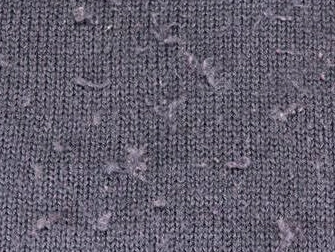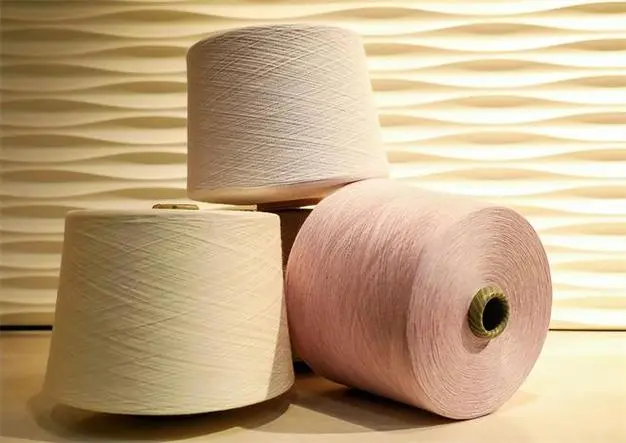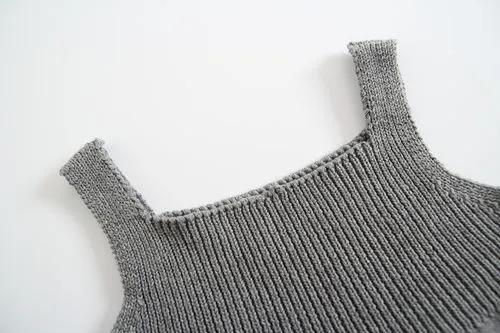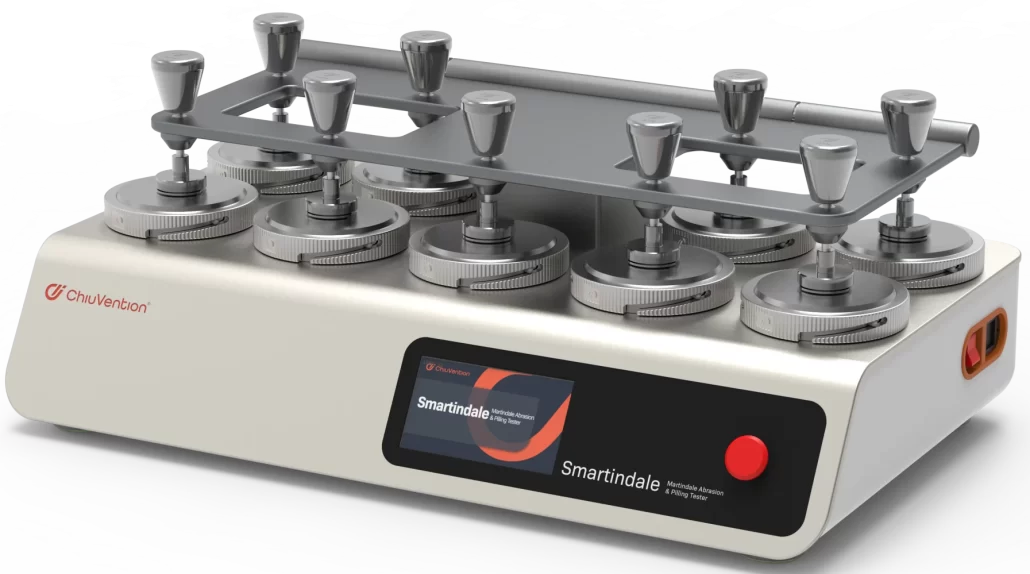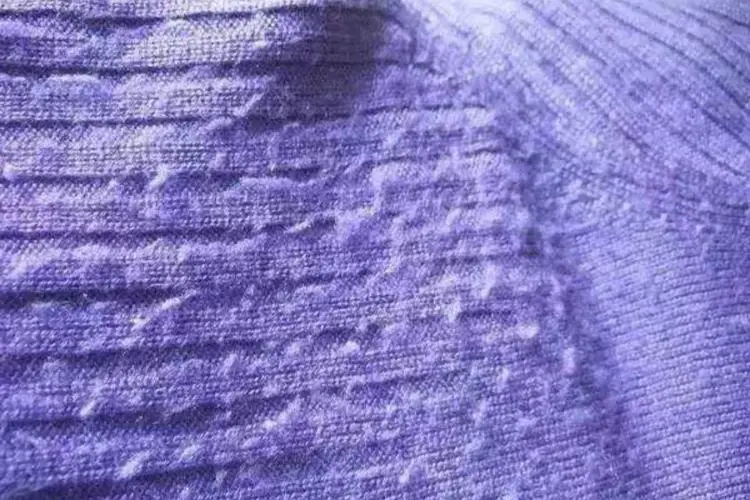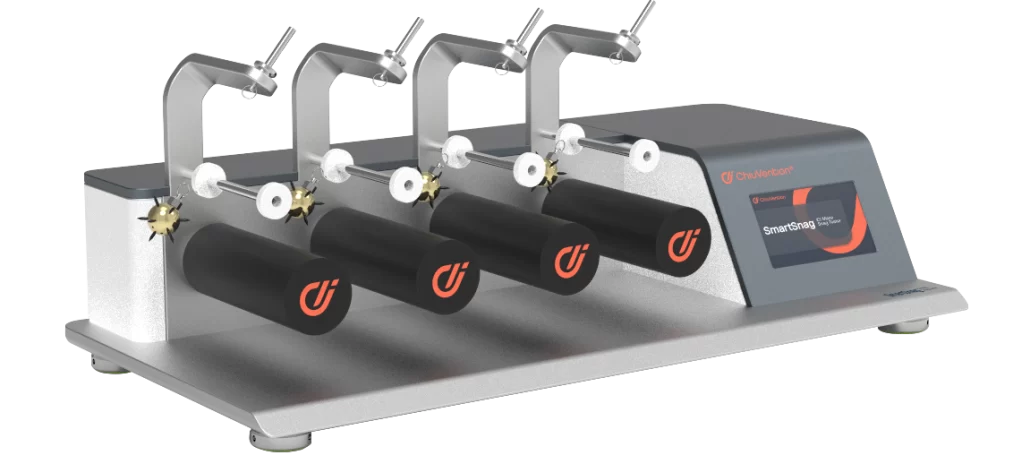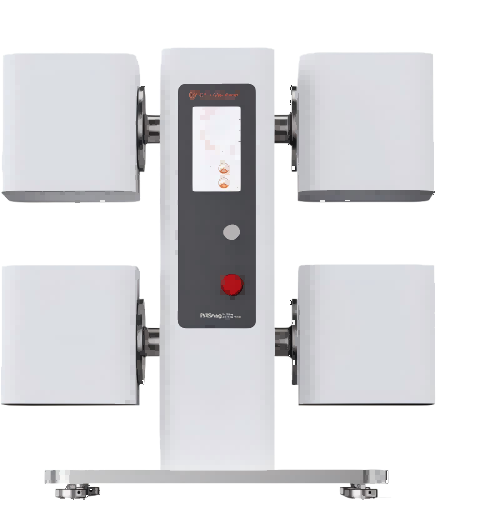Pilling of garments refers to a common problem. When worn, garments suffer friction. This exposes the surface fibres of the fabric. They then form pilling. With continued friction, the fibres become entangled and form small balls.
Pilling is a dynamic performance. The pilling speed often changes with the wearing time.
As consumers demand thin, soft, high-count fabrics, pilling is harder to control. They also have different views on acceptable pilling. Some products with acceptable pilling have received complaints. This confuses apparel companies. A classic problem in textiles is fabric pilling. Improving and even overcoming it is tough.
Definition of Hooking
In a process known as hooking, fibers and yarns pull out of the fabric surface. This happens due to hooking.
Knitted and woven fabrics with deformed filaments are very prone to hooking. This occurs when they encounter hard objects during use. It causes filament rings and/or tight yarn segments on the fabric’s surface. Encountering a sharp object with intense force can easily hook off a monofilament. This leaves a hairy filament protruding from the fabric.
Hooked fabrics look bad and are less durable.
Definition of Pilling
Pilling refers to the textiles or garments made of fabric. It occurs from washing, dry cleaning, or wear. Rubbing and friction cause the fabric’s fibres to protrude. This forms fuzz and changes the surface. Pilling is when the fuzz on a fabric forms a dense ball. This happens after a certain level of friction. The ball is so dense that light can’t pass through it, causing a projection. Anti-pilling refers to the ability of the fabric to resist surface piling due to friction.
Factors affecting fabric hooking
Fibre properties
a. Cross-sectional morphology: Round cross-section fibres feel waxy. Shaped cross-section fibres increase the fabric’s friction. They lose their waxy feel. Draw out these fibres from the yarn. This is laborious, and they are hard to hook.
b. Elongation: When sharp objects hook and pull the fabric, the elastic fibres stretch. They moderate the external force by their own elastic deformation. When you remove the external force, the elastic deformation returns. The pulled-out filament ring goes back to its original state. This weakens the hooking phenomenon.
Yarn Characteristics
The tighter the yarn structure, the more uniform the dryness. It is less likely to hook. Yarn fabrics are easier to hook than thread fabrics. High bulky yarns are easier to hook than low bulky yarns.
Organisation
Tighter fabrics have a flatter surface and are less likely to hook. Knitted fabrics are more prone to hooking than woven ones.
Anti-crochet ability: plain > basic twill > stripes > honeycomb > floating circle
Tightness
In the organisation, line density and breaking strength are similar. The tighter the fabric, the stronger the inter-fibre holding force. It is less likely to come undone from external forces. It has a good anti-hooking effect.
Clothing pilling factors
1. Fibre performance
Fibre strength
High-strength, wear-resistant fibers have high elongation and resist repeated bending. They don’t easily grind or wear off. But, they can cause hair clumps and hairballs to tangle into a larger mass. Low fibre strength. Hairballs form after friction. Easy to fall off the fabric. Therefore, high fibre strength is easy to pilling.
Fibre length
Short fibres pill more than long fibres. Filament is less prone to pilling than short fibres. Long fibres in the yarn friction resistance than short fibres, not easy to pull out of the yarn. In the same number of fibre sections, long fibres are less exposed to the yarn surface than short fibres. External forces are less likely to rub them. Polyester filament is high strength. It doesn’t wear or break easily under force. Polyester filament fabric is resistant to pilling.
Fibre fineness
The same raw material, fine fibres are more prone to pilling than coarse fibres. The thicker the fibre, the stiffer it is. The fibre ends, erected on the surface, are hard to bend. This causes pilling.
Inter-fibre friction
Inter-fibre friction is large, the fibre is not easy to slide, not easy to pilling.
Fibre blending is prone to pilling
Blended fabrics of chemical fibre, wool, cotton, and regenerated cellulose are prone to pilling. The strong, ball-like nature of the chemical fibre makes it less likely to shed. Fibre cross-section
The fibre has a shaped cross-section. It is stiff, hard to bend, and low in contact and friction. So, it won’t tangle or pill. Fibre curl
The curlier the fibre, the harder it is to stretch when twisting. The fibre will loosen and slip due to friction. This causes fluff to form on the yarn’s surface. So, the curlier the fibre, the more it will pill.
2.Yarn
Yarn factors affecting fabric pilling are mainly hairiness and abrasion resistance. These depend on the spinning method, process, twist, and structure.
Spinning method
Combed yarn has a relatively straight fibre arrangement. It has less short fibre and generally uses longer fibres. The yarn is less hairy. Therefore, combed fabrics are generally less prone to pilling.
Spinning process
The spinning process involves repeated stretching and carding of the fibre. Improperly setting the process parameters or faulty equipment can damage the fiber. This increases the short staple in the yarn, making it hairy. As a result, the fabric loses its anti-pilling properties.
Yarn twist
High twist can reduce the hairiness of the yarn, which is not easy to cause pilling. However, more twist will weaken the fabric and harm its feel and style.
Yarn Structure
Changing the yarn structure can also improve the abrasion resistance of the yarn to a certain extent. The new ring spinning technology changes the spinning mechanism. It gives the yarn a special structure. The new yarns are less hairy and have better fibre bonding. The fabrics are more resistant to abrasion and pilling than traditional spun yarns. This is true under the same process.
3.Fabric structure
Compactness
Loose structure of the fabric than the structure of the fabric is easy to hairy and pilling. The fabric’s structure and external objects cause friction. This makes it hard to produce fluff. If fluff does form, friction between the fibers stops it from slipping to the fabric’s surface. This reduces pilling. Knitted fabrics pill more. Their yarns have a larger, looser surface area. High-number fabrics are generally more compact. So, low-number fabrics are more prone to pilling than high-number ones.
Surface flatness
Surface flat fabrics are not easy to pilling, uneven surface fabrics are easy to pilling. Therefore, the anti-pilling property of fat-flower fabrics, common colour fabrics, ribbed fabrics and flat knitted fabrics is gradually increasing.
Pilling, fabric tightness, and surface smoothness are all related. So are the number of organisational intersections.
Knitted fabrics are more prone to pilling than woven fabrics.
Weft-knitted fabrics are more prone to pilling than warp-knitted fabrics.
Coarse gauge fabrics are more prone to pilling than fine gauge fabrics.
Ribbed fabrics are more prone to pilling than plain fabrics.
Lower-gauge fabrics are more prone to pilling than higher-gauge fabrics.
Thin and lightweight fabrics are more prone to pilling than heavy fabrics.
Same type of fabric. The tighter the organisational structure, the less prone to pilling.
4. Influence of dyeing and finishing process
The finishing process has a big impact on fabric pilling. After dyeing and finishing, anti-pilling treatments can cause large changes. This is due to the dyes, auxiliaries, and the dyeing and finishing process.
Dyes and dyeing weaken fibers and reduce friction between them. This affects pilling.
The purpose of softening treatment is to improve the feel and elasticity of the fabric. In the soft treatment process, too much softener will reduce friction between the fibres or yarns. This makes it easier for them to slip and pull apart. It will also reduce the fabric’s anti-pilling performance.
When refining a process, you must remove the oil. Otherwise, the oil in wearing and washing will adsorb small particles and hairs. This will reduce the anti-pilling effect. The residual oil will also reduce the fibre’s friction, causing it to move out and pill.
Reasonable optimisation of finishing process parameters: including temperature, finishing agent dosage, finishing time.
Fabrics prone to pilling
Wool and its blended fabrics:
Knitted jumpers, tweeds, woolen jumpers, etc.
Chemical staple fibre and its blended fabrics:
Polyester-cotton, polyester-viscose, acrylic-cotton, etc.
Knitted light fabrics:
Cotton raglan, modal, viscose, lyocell and other regenerated cellulosic fibre fabrics.
Cowboy embroidery
Influencing factors of fabric resistance test
The test for fabric abrasion resistance must be reasonable. It should define the abrasion test’s conditions. These are: the abrasive, the pressure, the friction path and rate, and the test environment.
Selection of abrasives
Abrasion testers use many types of abrasive materials. These include metal, emery, leather, plastic, rubber, brushes, and fabrics. Of these, metal, emery, and standard fabric are the most common. Different abrasives can wear in different ways. They can affect the test time and results. So, choosing an abrasive is key to the test’s validity.
Currently, various abrasion testers use single, unstable abrasives. This makes the results of different tests often incomparable and unreproducible. Certain abrasives, especially diamond, can damage the fabric. The specimen can have a shorter lifespan when worn. But, use the fabric in areas that will rub against wood, iron, and leather. This causes a slow wear. The instrument worn the specimen and damaged its fibers. So, it did not reflect the fabric’s actual condition. It is difficult to resolve a contradiction. We want to shorten the wear test time. But, we also want the abrasive wear to match actual wear as much as possible. To ensure the latter, we must sacrifice some of the former. This means picking a softer hardness, a milder fabric or abrasive, and longer wear tests.
The choice of pressure between the abrasive and the specimen
The abrasion test pressure and the fabric wear test results are proportional. Low pressure tests fabric surface friction. They better match real wear. But, they take longer. High pressure tests are shorter. But, they cause excessive wear. They do not reflect real wear, and results are unstable. The actual wear pressure is variable, but the test pressure is constant. So, the test pressure should be the average of the actual wear.
Friction movement trajectory and rate
Wear testing uses a fixed trajectory for the abrasive and specimen. This causes regular wear. In actual use, fabrics mostly suffer from irregular wear due to no fixed trajectory. This is one reason the test results differ from actual wear. If the instrument’s wear trend matches the fabric’s, it helps. The fabric’s warp direction is heavier, for example.
Friction acts like a dynamic load. The faster the friction, the greater the impact. The current rapid test has the phenomenon of high rate, which is very different from the actual use. If the rate is too fast, the abrasion will be too violent. Also, the lack of buffer time will affect the fabric’s slow elasticity at the impact point.
Testing environment
The test’s temperature and humidity will affect the results. The impact will vary for different fibres. Temperature affects natural fibres less than synthetic fibres. This is because the initial modulus of synthetic fibres is more sensitive to temperature. The closer the temperature is to the softening point, the greater the effect. But, it is not significant at room temperature. Humidity greatly affects the abrasion resistance of viscose fibres. It also affects nylon, but to a lesser extent. It has little effect on polyester and waxy fibres.
Reasons for Hooking
Lint or fine fibers on the surface of the fibers cause textile hooking. They can grip other fibres or hard objects. This phenomenon is usually due to lint or fine fibres on the surface of the fibre. Friction or compression stretches, bends, or twists them. This forms a hook-like structure and generates the hooking phenomenon.
Long-term friction causes textile pilling. It makes the yarn’s fibers appear hooked or fuzzy. This leads to a lot of fuzz on the textile’s surface. The fuzz gets tangled due to static electricity. The strong fibers can’t detach from the textile, forming balls of hair. For example, common fabrics such as wool, nylon and polyester are prone to pilling.
Why do clothes pill?
Worn clothing is subject to friction. It draws, hooks, and pulls out the fabric’s fiber ends. This creates small, fuzzy balls on the fabric’s surface. People know this process as pilling. As the hair plume is gradually drawn out, it will be more than 5mm above. Then, it will bear the friction. The fibre ends will hook to each other. This will form irregular, ball-shaped clumps known as pilling.
With continued friction, the fabric’s fibres form a ball. The repeated folding and fatigue have broken the fibres. They now connect to the fabric in various directions. The ball then comes off the fabric. But, with continued use, the broken ends of the fibres will form new balls again.
Wool and chemical fibres tend to pill, especially coarse, carded wools and cashmere. Twill and satin fabrics are prone to pilling. They have a small yarn twist, more hair, a loose structure, and long floating threads.
Why do clothes hook?
Fabric hooking is mainly caused by yarn slip. It relates to the fabric’s structure. Woven fabrics are better than knitted ones in the hooking test, if they have the same components. Jacquard, mesh, and terry knits are more prone to hooking than ordinary ones.
Pure cotton does not pilling?
Pure cotton will also pill! Any surface with hairy fabrics will, after use, have some pilling. Only cotton will show it less.
Chemical fibre fabrics are more prone to pilling than cotton ones. This is because chemical fibres are stronger than cotton. After pilling, the hairballs on chemical fibre fabrics are hard to remove. They stubbornly stick to the fabric’s surface. Cotton fabrics on the hairballs in the wash and friction gradually fall off. So, people believe “cotton will not pill.”
Of course, cotton has many grades. Its fibre length varies. Long fibres have fewer ends. They are less prone to hairball formation.
Also, the processing form shows that the fabric has a compact, flat structure. It has a general fibre twist, fibre, and fibre holding force. So, it is not easy to hairball. On the contrary, blended fabrics pill more. It’s worse for nylon, polyester, and polypropylene. This is due to the different fibers and their twists. The fabric surface tends to produce lint.
The process of fabric pilling
Pilling:
Pilling is initially produced along the longitudinal direction of the fibres. External friction can harm the fabric. If the friction exceeds the fibre strength, it will pull out the fibre ends. This forms rings and fluff. The fabric will then lose its luster.
Tangled into a ball:
In the dense area of the pile, the loose fibres become entangled. When the pile exposed to a certain length, it rubbed. The friction caused repeated elongation and retraction, tangling it into a ball. The hairball is small. It does not form a dead knot. The fabric buries one end and connects it to the cloth’s surface. Hairball easy to hide dirt, affecting the beauty of the fabric.
Hairball growth:
Tangled fibres close to form small balls. These small balls grow, hanging on the fabric’s surface by the strong fibres.
Hairball shedding:
Friction will stretch and bend the ball’s fibres. They will break and come off the fabric. People often feel that a fabric is not prone to pilling. This is inconsistent with the reality. The fabric pills easily because the pom-poms have a short life.
How does the tester test for pilling?
Before making a garment, a fabric must pass tests, including one for pilling. This ensures the garment is safe and comfortable.
The test method standards for clothing pilling and hooking are:
GB/T 4802.2-2008 Modified Martindale Method
GB/ T 4802.3-2008 Pilling box method
GB/T 11047-2008 Nail hammer method
All the methods test fabric pilling. But, they suit different fabrics. Also, the instruments work on different principles. No matter the method, the test results are grades. They range from 1 to 5. A higher grade means the clothes are less prone to pilling. The standard generally qualifies that the index ≥3.
A principle serves as the basis for GB/T 4802.2-2008 ‘Modified Martindale Method’. A circular specimen must rotate freely around its axis, under a specified pressure. It rubs against the same fabric or woolen abrasive with a trajectory of the Li Shaju graph. This method is for testing bedding.
In the ‘pilling box method‘ of GB/T 4802.3-2008, you mount the specimen on a polyurethane tube. Then, a wooden box lined with cork turns it over randomly at a constant speed. After taking a set number of turns, we perform a visual test to check for pilling. It is applicable to the testing of jumper textiles.
The GB/T 11047-2008 Nail Hammer Method is as follows. Someone places a cylindrical specimen on a rotating cylinder. A nail hammer, suspended by a chain, is then dropped onto the specimen’s surface. A constant-speed rotation of the cylinder causes the nail hammer to randomly reverse and jump on the specimen’s surface. This hooks the specimen and creates a hook on its surface.
Test Note: Sample non-clothing sent for inspection. Please mark the front to avoid testing errors. For combing, coarse combing, etc., the parameter requirements differ. So, pay attention to the choice of parameters.
Martindale Abrasion Pilling and Pilling Test Procedure
(1) Specimen Preparation
Cut 3-4, 38mm diameter round specimens from different parts of the sample. Then, put them in a constant temperature and humidity environment for a time. Then, test them.
(2) Instrument Preparation
Check if each part of the instrument is normal. Also, check if the abrasive, foam, and felt meet the test requirements.
(3) Clamping the specimen for measurement
①Place the specimen clamping nut on the martindale abrasion and pilling tester table’s mounting device. Position the friction side of the specimen facing down and center it in the clamping nut. When mounting the specimen, avoid distortion of the fabric. When the mass per unit area of the specimen is less than 500 g/m2 , place the foam liner on the specimen. When the mass per unit area of the specimen is greater than 500 g/m2 , the foam liner is not required. Insert the specimen fixture into the compression nut. Then, tighten the specimen fixture sleeve.
② Remove the fixture guide. Place the felt on the abrasive table. Then, place the abrasive on the felt. Place the abrasive on the felt. The yarns of the abrasive fabric must be parallel to the edge of the instrument table. Place a weight of (2.5±0.5) kg and a diameter of (120±10) mm on the felt and abrasive material on the grinding table. Tighten the clamping ring to fix them in place. Then, remove the weight.
③ Start the instrument. Rub the specimen until you reach the pre-set number of rubs. Carefully remove the specimen fixture, with the specimen, from the instrument. Do not damage or distort the yarn. Then, check for breakage on the entire rubbing surface of the specimen. If there is no breakage, reattach the fixture. Test it at the next inspection to identify breakage at the end of the friction. Use a magnifying device to view the specimen.
ICI Mace Snag Tester test steps
Check the specimen for defects that may affect the anti-hooking test. Look for accidental hooking or puckering. Replace the specimen if it fails the test. If you can’t replace the specimen (e.g. pilling after washing), note the defects. Then, exclude them from the hooking resistance test.
Carefully place the specimen on the cylinder, front side out. Spread the sewing edge to both sides to smooth the opening. Then fix one end of the specimen with a rubber ring. Unfold all the folds to make the surface smooth. Then, fix the other end of the specimen with a rubber ring.
●If the instrument has multiple rotors, use half lengthwise and half widthwise rotor specimens.
● Place the nail hammer on the rotating cylinder and allow it to rotate freely.
● Set the specified 600 rpm and start the tester.
● Remove the specimen with the seam in the centre of the back of the specimen.
●After the specified revolutions, rate the specimen’s hooking. Compare it to a standard sample photo.
Test Procedure for ICI Pilling and Snag Tester
Specimen Preparation and Pretreatment.
Cut 4 specimens of 125 x 125 mm. Each must have a different warp and weft yarn. Mark the reverse side to show the lengthwise direction. Cut another piece of specimen of the same size as the original sample for rating.
Fold the front of the sample inwards. Use two pieces along the warp direction and two along the weft direction. Then, sew a seam 12mm from the edge. The sample should now be a tube.
Cut 6mm off each end of each sample to remove any distortion from the stitching. Fit the sample onto the polyurethane carrier tube and secure it with PVC tape. Expose 6mm of each end of the polyurethane. The length of the tape should not exceed 1.5 times the circumference of the polyurethane tube.
Test Procedure.
Clean the puckering ICI Pilling and Snag Tester. Place the sleeved sample tube inside. Close the lid securely. Set the required number of revolutions. For coarse textiles, the number of revolutions is normally 7,200; for fine textiles, 14,400.
The test activates the puckering box. At the end, remove the specimen and the stitching. It is now ready for grading.
Rating Evaluation.
Under a standard light source, grade the specimen against a standard sample photo. We use a five-point scale, with 1 representing the worst and 5 representing the best. The specimen’s pilling rating comes from comparing it with others. Several raters analyzed it in the rating box’s observation window.
Test Ratings
Nail hammer hooking test
| Number of grades | Condition Description |
| 5 | No change in surface |
| 4 | Slightly hooked and/or tight segments on the surface. |
| 3 | Surface severe hooks and/or tight yarn segments, hooks of different densities (tight yarn segments) covering the entire surface of the specimen. |
| 2 | Surface severe hooks and/or tight yarn segments, hooks of different densities (tight yarn segments) covering the entire surface of the specimen. |
| 1 | Surface severe hooks and/or tight yarn segments, hooks of different densities (tight yarn segments) covering the entire surface of the specimen. |
Martindale Pilling and Snagging Test, Snagging Box Test Ratings
| Number of grades | Condition Description |
| 5 | No change |
| 4 | Slight surface pilling and/or light pilling |
| 3 | Moderate surface hairiness and/or moderate pilling, with balls of different sizes and densities covering part of the surface of the sample. |
| 2 | Significant surface pilling and/or puckering, with balls of different sizes and densities covering most of the surface of the sample. |
| 1 | Severe surface pilling and/or puckering, balls of different sizes and densities covering the entire surface of the specimen |
Measures to avoid or reduce garment pilling
Clothing will pilling is the result of both intrinsic and extrinsic factors. The intrinsic factors are the fabric’s material and structure. The extrinsic factors are the external forces on the fabric when people wear the clothes. If you can’t change the intrinsic factors, reduce friction to avoid pilling.
01 When buying clothes, choose natural-fibre (except wool) materials, like cotton, hemp, and silk. Clothes made from chemical fibers (polyester, polyamide, acrylic) and blends are more prone to pilling. They pill more than other fabrics.
02When buying, choose clothes with a tight structure and smooth surface. Regenerated cellulose fibre clothes are less prone to pilling. So are chemical fibre filament clothes and those with anti-pilling finishes.
03For wool and cashmere coats, a higher content of both means less pilling. A flatter, denser surface also means less pilling. When washing, avoid machine washing. It increases fabric friction. Use a neutral detergent. Washing can add some fabric softener. Cashmere and wool sweaters can use a special detergent. It has some anti-pilling additives.
04 For knitted garments, both the inside and outside should be smooth. Wash clothes inside out, and avoid hooks and sharp objects. This reduces friction on the garment’s surface and helps prevent pilling.
05 After using a hairball trimmer to remove pilling, do not stick or pull off. It will elongate the fibers and cause more pilling. Some prefer easy-to-pill clothes, like wool and cashmere sweaters. They avoid friction with hard objects. For example, with your backpack.
Hooking prevention methods
a. You can choose raw material with a shaped cross section, a big twist, and good elongation.
b. Spinning: Improve the yarn’s evenness and increase the twist (7-8 twists). Also, adjust the F number; a larger F number makes it easier to hook.
c. Weaving: Choose appropriate fabric organisation and tightness.
d. Finishing: Add hydrophilic silicone oil to improve it, up half a grade. For woven fabrics: heat setting, resin finishing.
For more information on textile testing methods/standards
or textile testing machines, contact us:
What’s App: +86 180 2511 4082
Tel: +86 769 2329 4842
Fax: +86 769 2329 4860
Email: medium@chiuvention.com

